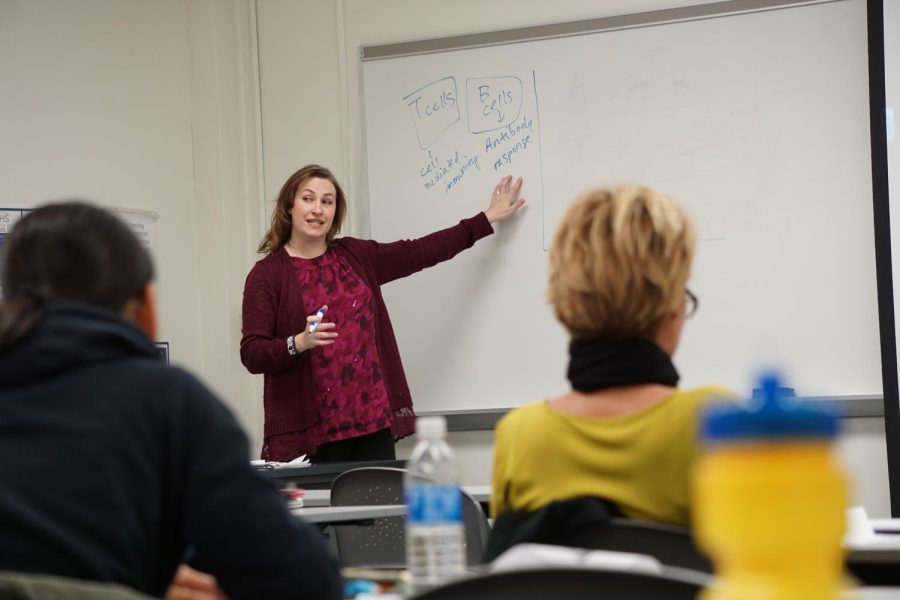Zombie outbreak infiltrates health professor’s lesson plan
Kent State associate professor Tara Smith teaches during her “Epidemiology of Infectious Disease” class on Monday, Feb. 13, 2017.
February 16, 2017
Students may now be one step closer to surviving the zombie apocalypse — or at least one step closer to understanding how one might occur.
Tara Smith, a microbiologist, infectious disease epidemiologist and associate professor of environmental health sciences and epidemiology, teaches her students how infectious diseases are spread by citing zombie outbreaks in popular culture. Smith uses media including “The Walking Dead,” “28 Days Later” and “World War Z” as a way to explain infections to her students.
Smith said she has been fascinated with zombies since she was young.
“I’ve always had an interest in the horror and science fiction genres; I grew up on Stephen King and fell in love with ’28 Days Later,'” Smith said. “My incorporation of zombies into my work and teachings really just stemmed from there.”
Smith uses zombie outbreaks to teach her students about zoonotic infections — diseases transferred between animals and humans, such as HIV, Ebola and the Zika virus. She said she incorporates zombie outbreaks into her curriculum as a way of inspiring interest in her students about the diseases that are actually occurring throughout the world.
“In a lot of places in the world, infectious diseases are still a number one killer,” Smith said. “By using zombie outbreaks as the example, I can teach my students how these diseases are spread, just in a more compelling way.”
Christopher Woolverton, a professor of environmental health sciences, said Smith’s unique, yet traditional teaching methods are an effective way of getting students captivated in the field of epidemiology.
“Smith has spiced up her classes and made them much more engaging,” Woolverton said. “We hear from a lot of our students just how exciting and pertinent her classes are, especially with today’s fascination with the zombie apocalypse.”
Gino Cioffi, a public health graduate student in Smith’s epidemiology infectious disease class, said Smith’s integration of zombies into the curriculum has made the class come to life.
“I look forward to coming to class because of (Smith),” Cioffi said. “Her energy and her incorporation of the zombie apocalypse makes it really easy to get into the material and follow along.”
Smith also integrates zombie folklore into her work outside of her classes.
In December 2015, Smith published an article in the British Medical Journal that summarized the epidemiology and pathology of zombie infections and what needs to be done to prepare for a zombie apocalypse.
Smith is also a member of the “Zombie Research Society,” an organization created by authors, filmmakers and scientists as a means of collaboration between the three fields.
“We help writers and filmmakers make their zombie movies as realistic as they can be, considering the circumstances,” Smith said. “We don’t really research zombies, of course, but we do help people write realistic stories about them.”
Currently, Smith is researching methicillin-resistant Staphylococcus aureus (MRSA) bacteria, an antibiotic-resistant type of staph, in both man-made and natural environments in a laboratory on campus.
Smith currently offers two classes in epidemiology: “Epidemiology of Infectious Disease,” which is a graduate-only class during the spring semester, and “Plagues and Pandemics: How Infection Shaped Culture and History,” a graduate and undergraduate class during the fall semester.
Clair Yee, senior public health major, said it’s compelling from an epidemiologist’s perspective to see how Smith relates zombies to real-life diseases in her work.
“We always write off zombies as kind of a joke,” Yee said. “But it’s really fascinating to see (Smith) walk back through these works of fiction to actually show how the infections could be possible and how we would really prepare for them in real life.”
Abigail Winternitz is the College of Nursing and public health reporter, contact her at [email protected].

























